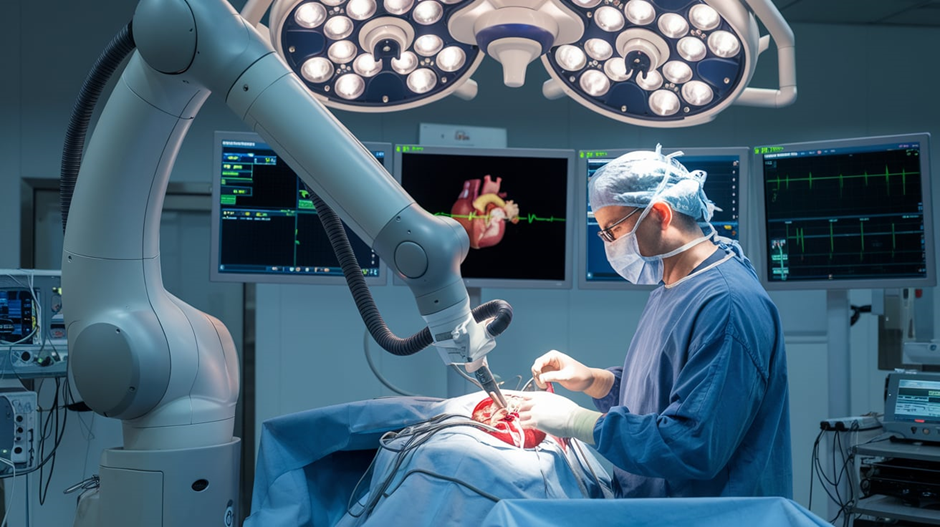Artificial Intelligence (AI) is rapidly reshaping healthcare, with particular promise in surgical fields such as spinal disc replacement. Through real-time data analysis, predictive modeling and precise guidance, AI supports surgeons in making data-informed decisions, aiming to enhance precision and potentially reduce complications. In spinal disc replacement surgery, where accuracy is paramount, Dr. Larry Davidson, an expert in spinal surgery, stresses that AI helps optimize implant placement, safeguard surrounding tissues and ensure that each procedure aligns with the patient’s unique anatomy.
The Role of AI in Surgical Decision-Making
In the high-stakes environment of spinal surgery, every decision counts. Even small deviations in alignment or placement can lead to complications such as nerve damage, instability or implant failure. AI technology supports surgeons by analyzing vast datasets and drawing from an array of similar cases, helping identify optimal decisions for each unique situation. From preoperative planning to real-time intraoperative support, AI contributes additional insights that support precise, informed choices at each stage of the surgery.
How AI Enhances Preoperative Planning
Effective preoperative planning is crucial to minimizing complications in disc replacement surgery, and AI offers powerful tools to support this process. Advanced AI algorithms can analyze a patient’s CT or MRI scans in conjunction with their medical history to generate a highly accurate 3D model of their spine. By evaluating factors like bone density, disc spacing and spinal curvature, AI can predict potential challenges and suggest the best surgical approach tailored to the patient’s specific anatomy.
- Risk Assessment and Prediction
Using predictive modeling, AI systems can forecast potential risks and complications based on data from thousands of similar cases. This supports surgeons in identifying high-risk areas, helping them prepare for contingencies and potentially reducing unexpected challenges. With AI’s help, surgeons can anticipate complications before they arise, giving them a chance to refine their approach for safer outcomes. - Optimizing Implant Placement
AI-driven systems can simulate various implant positions and angles, helping determine the best placement that aligns with the patient’s anatomy. By comparing multiple simulations, the technology can recommend a configuration that minimizes stress on the spine and reduces the risk of implant displacement or wear over time. This tailored approach is especially valuable in complex cases where traditional methods might struggle to account for subtle anatomical variations.
Real-Time Decision Support During Surgery
AI contributes to real-time decision-making during surgery, supporting precision and potentially minimizing complications. Through live monitoring and continuous data analysis, AI systems provide immediate feedback to guide the surgeon’s decisions, ensuring that each step aligns with the pre-established plan.
Continuous Monitoring and Feedback
During the procedure, AI can continuously track the position of surgical tools, the implant and the surrounding anatomy, alerting surgeons to any deviations from the planned path. If the implant is not positioned correctly or if an instrument nears a critical nerve, the system can provide instant feedback, allowing the surgeon to make quick adjustments and avoid unintended damage.
Adaptive Learning and Customized Adjustments
Advanced AI systems can adapt based on the surgeon’s movements and the patient’s unique anatomy, dynamically adjusting the guidance to support optimal placement. By learning from each action in real-time, AI fine-tunes its recommendations, ensuring they remain relevant and accurate as the surgery progresses. This adaptability is crucial for reducing risk in complex spinal procedures where conditions can change unexpectedly.
Reduced Dependency on Imaging
Traditionally, spinal surgeries require repeated imaging during the procedure, exposing both patient and surgeon to radiation. AI-driven guidance may reduce the need for frequent imaging by providing continuous feedback, potentially lowering radiation exposure.
Improving Postoperative Outcomes and Long-Term Success
AI’s influence may extend to postoperative outcomes. By supporting surgical precision and implant positioning, AI has the potential to enhance long-term outcomes. More accurate implant positioning leads to fewer revisions, reduced postoperative pain and a quicker return to normal activities. AI’s predictive capabilities also help in monitoring patient recovery, allowing for customized follow-up care that can address issues early on and improve overall patient satisfaction.
- Enhanced Stability and Durability of Implants
Proper implant positioning and alignment are essential for implant longevity. By reducing friction, stress and wear, AI helps ensure that the implant remains stable and functional for longer, reducing the need for revision surgeries down the line. This translates to fewer complications, improved mobility and a more satisfying outcome for patients. - Streamlined Recovery Process
When complications are minimized and surgical precision is maximized, the recovery process becomes smoother and faster. AI-supported surgeries often result in reduced postoperative pain and fewer physical limitations, allowing patients to resume daily activities sooner. This enhanced recovery process can significantly impact the patient’s overall quality of life.
The Future of AI in Spinal Disc Replacement
The future of AI in spinal disc replacement looks promising, with advancements expected in predictive analytics, personalized care and patient monitoring. As AI systems continue to evolve, they may integrate more advanced imaging and augmented reality to provide even greater insight into each procedure. With continuous learning capabilities, AI may help refine surgical approaches over time, supporting safer and potentially more effective procedures.
Additionally, AI might help identify patients who would benefit most from specific disc replacement options, ultimately tailoring procedures to their unique needs. As AI becomes more integrated into surgical practices, spinal disc replacement surgery will continue to advance, offering more precise, personalized and complication-free solutions for patients.
AI’s role in spinal disc replacement is transforming how surgeons approach complex procedures, bringing a new level of precision and risk management to the operating room. From preoperative planning to real-time guidance, AI facilitates data-driven support, aiming to enhance precision, optimize implant placement and improve potential outcomes for long-term patient health.
As AI technology progresses, Dr. Larry Davidson notes, “AI will provide us with the ability to have a total and comprehensive understanding of the patient’s medical history and what sort of spinal interventions would be considered as best practices. It’s easy to envision how AI will enable us to quickly review and summarize existing medical literature regarding specific types of patients with unique medical conditions and their outcomes following certain spinal surgical procedures. It is in this fashion that we will be able to apply the most optimal treatment options for each individual patient.”
AI’s contributions to spinal surgery will become even more pronounced, making spinal disc replacement safer, more effective and more tailored to each patient’s unique needs. With advancements in machine learning and predictive analytics, surgeons will be able to anticipate potential complications and make more informed decisions. This evolution not only improves patient care but also sets new standards for efficiency and reliability in spinal procedures.




